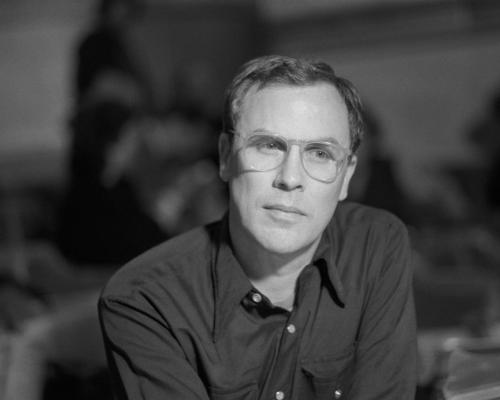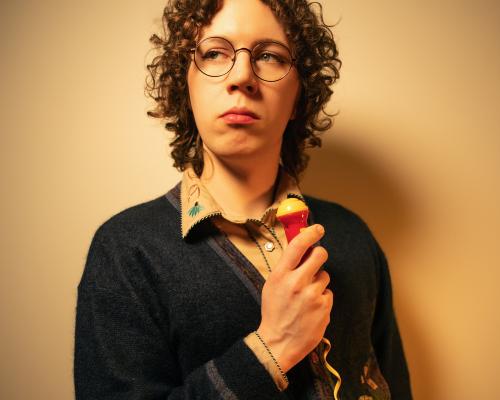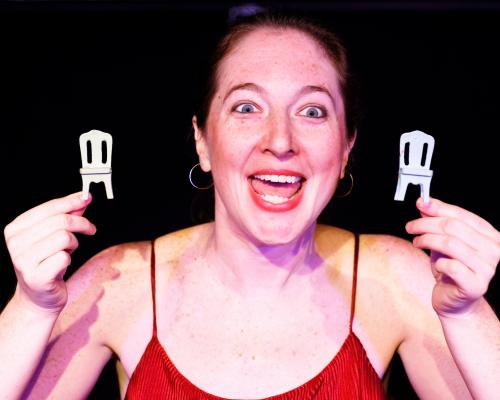
The career of Robert Wilson, the visionary performance artist, designer – of furniture, stage sets, costumes – and director, was surely the last hurrah for the heavily subsidised and sponsored American and European avant-garde theatre of the 1970s.
Wilson’s financially expensive, physically expansive, beautifully lit and choreographed work – lots of sculptural silhouettes, time-stretching slow motion, and haunting soundscape – was first seen in Britain at the Royal Court in 1978. This show was I Was Sitting on My Patio This Guy Appeared I Thought I Was Hallucinating. Wilson and the choreographer Lucinda Childs appeared in a Hockneyesque stage picture, unlike anything previously seen in Sloane Square, the home of new British playwriting: a minimalist, austere design of a telephone, a telephone wire and a gauze over the front of the stage with projected images on it.
What was it about? This was a question Wilson never countenanced. He created what the New York Times critic Mel Gussow called “a cosmos of the arts”. The enigmatic Wilson, who has died aged 83, claimed that he gave audiences time and space in which to think. What they thought about was none of his concern.
With the composer Philip Glass, his great friend and collaborator, in their first work together, the five-hour Einstein on the Beach (1976) staged at the Avignon festival, and the Met in New York, he expanded his early ideas of plotless tableaux, in a text, with no dialogue, covering nuclear power, space travel and Einstein’s enthusiasm for playing the violin.
Wilson’s major extraordinary work, KA MOUNTAIN AND GUARDenia TERRACE, which became a cause celebre in 1972, played for 168 hours, with a cast of hundreds, over seven days on an Iranian mountaintop at the pre-revolutionary Shiraz arts festival, and embraced poetic surrealism, backlit silhouette, community involvement and audience endurance to an unprecedented (and still unsurpassed) degree. It was all about pushing the boundaries of the art form.
Wilson’s first company in 1960s New York was formed, lived and worked in his SoHo loft, while his later work emanated from – and was often installed in – the Watermill Center for the arts, founded by Wilson on Long Island.
He was an unashamed opponent of Method theatre and Stanislavski naturalism. “To see someone try to act natural on stage,” he told the New York Times in 2021, “seems so artificial. If you accept it as being artificial, in the long run, it seems more natural, for me.”
This attitude stemmed from his early life, when he was sent by his parents, Diugiud Mims Wilson, a wealthy lawyer, and Velma Loree (nee Hamilton), to study dance to correct his fierce stammer and lack of self-confidence. The patterns of repetitive statement as defiant argument coloured his life work.
Born in Waco, Texas, he went to Waco high school, then the University of Texas at Austin in 1959 to study business administration, and began working at the Austin State Hospital for the Mentally Handicapped, where he helped patients express themselves through art. This was his second major formative experience and, again, influenced all his subsequent work in theatre.
He went on to study architecture and interior design at the Pratt Institute in New York, and designed puppets for Jean-Claude van Itallie’s America Hurrah, which played at the Royal Court in 1965 (it was banned by the lord chamberlain for crude satirical remarks about the US president Lyndon Johnson, but was performed for club members).
Wilson returned to Texas, where he fell out with his deeply religious parents (he was gay and worked in theatre) and, after a suicide attempt, was institutionalised for six weeks. Back in New York, he supported his writing with teaching.
In 1968, he got involved in an altercation between a police officer and a young black boy, Raymond Andrews, who was deaf and speech-impaired. He went on to defend Andrews in court and, with the agreement of his parents, to adopt him; Andrews was his collaborator on his first silent epic, Deaf Man Glance (1971), which ran for seven hours at the Brooklyn Academy of Music.
Two Edinburgh festival visits, serious treats, stick in the memory. In 1993 Doctor Faustus Lights the Lights was a perfect posthumous alliance with Gertrude Stein, a beautiful, marionettish shadow play of quiet misery – funny and surprising – based on Stein’s long forgotten 1938 technological variation on the Faust legend: trance and repetition, an iterating pulse of spare and beauteous incantation, a world of sighs and dreams.
And in 1996 Orlando was an exotic melange of light, sound and music, with an unforgettable Miranda Richardson at its sideways-on gestural centre, and text by the American poet and novelist Darryl Pinckney, an adaptation of Virginia Woolf’s iconic account of a transsexual time-traveller from the court of Elizabeth I to the late 1920s, in the overlapping styles of Ronald Firbank, Algernon Swinburne and Oscar Wilde.
Other collaborations included The Black Rider (1990), with Tom Waits, William Burroughs and Marianne Faithfull, which played at the Barbican Centre in 2004; Schubert’s Winterreisse with Jessye Norman in 2001; and, with Mikhail Baryshnikov and Willem Dafoe, Daniil Kharms’s The Old Woman, a hypnotic, surreal, clown-like Beckettian scenario, translated by Pinckney, which went to the Manchester international festival in 2013.
Among Wilson’s later, chamber-scale forays into the classical repertoire, I most enjoyed his version of Heiner Müller’s Hamletmachine (based on a short 1977 play) at the Almeida in Islington in 1987; and a stunning reappraisal of Beckett’s Krapp’s Last Tape – Wilson as a shock-haired, white-faced, petrified inhabitant of an archive, not just the tape-recorder – in a terrifying thunderstorm, which visited the first Enniskillen Beckett festival in 2012, and the Barbican Centre in 2015.
From 2013, Wilson produced a ream of video portraits of famous performers – Lady Gaga, Brad Pitt, Winona Ryder, Renée Fleming and Alan Cumming – in historic roles. These have been screened in 50 museums and galleries around the world.
Wilson never ceased pushing boundaries or conjoining what Peter Brook, late in life, described as the now defunct avant-garde with the latest in technology and popular culture.
He is survived by Andrews, and by his sister, Suzanne.
• Robert Mims Wilson, director, designer and performer, born 4 October 1941; died 31 July 2025




